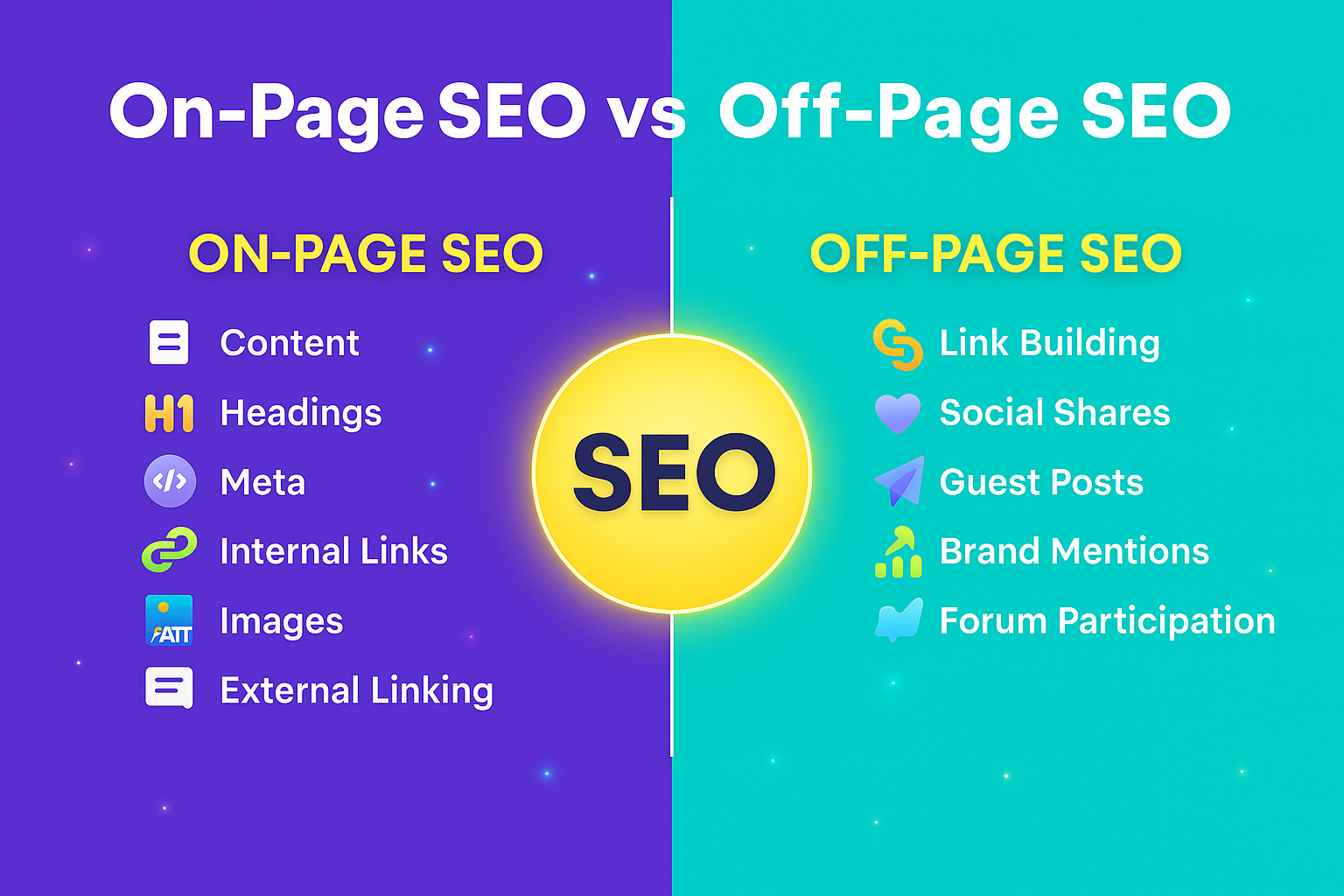Introduction
The difference between On-Page SEO and Off-Page SEO is simple. On-Page SEO focuses on everything you do on your own website, like content, headings, images, and links. Off-Page SEO focuses on things outside your website, like backlinks, social shares, and mentions from other sites.
Key Differences Between On-Page and Off-Page SEO
| Aspect | On-Page SEO | Off-Page SEO |
|---|---|---|
| Definition | Optimization done on your website | Optimization done outside your website |
| Purpose | Helps search engines understand your page topic | Builds website authority and trust |
| Examples | Content, meta tags, headings, images, internal links | Backlinks, social shares, guest posts, brand mentions |
| Control | Fully under your control | Partially under your control |
| Impact | Immediate ranking signals | Long-term ranking & credibility |
What is On-Page SEO?
On-Page SEO is all about optimizing elements on your own website. The main goal is to make your content and pages clear and understandable for both users and search engines.
On-Page SEO Checklist (with Short Descriptions)
-
Title Tags & Meta Description
Create clear and engaging titles and meta descriptions so search engines and users understand your page.
-
Headings (H1, H2, H3)
Organize content with headings. H1 for the main title, H2/H3 for subtopics. -
Content (Text, Audio, Video)
Use high-quality text, audio, and videos. Properly optimized content is the backbone of On-Page SEO. -
Search Intent
Match your content to what users are looking for: informational, navigational, or transactional. -
Keyword Placement
Include target keywords naturally in titles, headings, paragraphs, and image alt texts. -
Internal Linking
Link to other relevant pages on your site so users can explore and Google understands site structure. -
Image Optimization
Compress images, add alt texts, and maintain proper sizes for fast loading and SEO. -
URL Structure
Keep URLs clean and readable, reflecting your page topic (example: yourwebsite.com/on-page-seo). -
Mobile-Friendly & Page Speed
Ensure your website is responsive and loads fast on all devices. -
Schema Markup
Add structured data like FAQs, reviews, or articles to help search engines better understand your content.
What is Off-Page SEO?
Off-Page SEO focuses on optimizations done outside your website. It signals to search engines that your site is trusted and authoritative, which helps boost your ranking over time.
Off-Page SEO Checklist (with Short Descriptions)
-
Backlinks
Acquire high-quality backlinks from relevant, authoritative websites. -
Guest Posting
Publish content on trusted blogs with links back to your site. -
Social Media Signals
Share content on platforms like Facebook, LinkedIn, and Instagram to increase engagement. -
Brand Mentions
Mentions of your website or brand on other sites, even without backlinks, build trust. -
Influencer Outreach
Collaborate with industry influencers to share and promote your content. -
Forum & Community Participation
Engage in niche-relevant forums and communities like Reddit or Quora. -
Local Listings & Citations
Ensure your business is listed in directories like Google My Business, Yelp, and Bing Places. -
Reviews & Testimonials
Collect positive reviews and testimonials on Google, Yelp, or industry platforms. -
Content Syndication
Republish your content on trusted platforms to increase reach and visibility. -
Press Releases
Publish newsworthy updates through press release platforms to gain high-authority backlinks and recognition.
Conclusion
On-Page SEO and Off-Page SEO are both important parts of a successful SEO strategy. On-Page SEO helps you make your website organized, clear, and user-friendly, while Off-Page SEO builds trust and authority by showing search engines and users that others value your site.
By combining both, you can improve your website’s rankings, attract more visitors, and build credibility. In short, focus on optimizing your site from the inside and promoting it from the outside to get the best SEO results.


